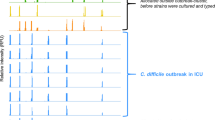Abstract
A large hospital outbreak ofClostridium difficile diarrhea at the Minneapolis Veterans Administration Medical Center (MVAMC) was studied by plasmid profile typing. Plasmids were obtained from 30 (37 %) of 82 clinical isolates from MVAMC patients and 10 (67 %) of 15 non-MVAMC isolates. While bacteriophage plus bacteriocin typing and polyacrylamide gel electrophoresis (PAGE) plus bacterial agglutination typing proved more universally applicable, plasmid profiles may be useful for tracing isolated epidemic outbreaks, reinfections and relapses caused by plasmid-bearing strains.
Similar content being viewed by others
References
Bartlett, J. G., Chang, T. W., Gurwith, M., Gorbach, S. L., Onderdonk, A. B. Antibiotic-associated pseudomembranous colitis due to toxin-producing clostridia. New England Journal of Medicine 1981, 298: 531–534.
Gerding, D. N., Olson, M. M., Peterson, L. R., Teasley, D. G., Gebhard, R. L., Schwartz, M. L., Lee, J. T., Jr. Clostridium difficile-associated diarrhea and colitis in adults: A prospective case-controlled epidemiologic study. Archives of Internal Medicine 1986, 146: 95–100.
Cumming, A. A., Thomson, B. J., Sharp, J., Poxton, I. R., Fraser, A. G. Diarrhoea due toClostridium difficilie-associated with antibiotic treatment in patients receiving dialysis: the role of cross infections. British Medical Journal 1986, 292: 238–239.
Sell, T. L., Schaberg, D. R., Fekety, F. R. Bacteriophage and bacteriocin typing scheme forClostridium difficile. Journal of Clinical Microbiology 1983, 17: 1148–1152.
Mulligan, M. E., Halebian, S., Kwok, R. Y. Y., Cheng, W. C., Finegold, S. M., Anselmo, C. R., Gerding, D. N., Peterson, L. R. Bacterial agglutination and polyacrylamide gel electrophoresis for typingClostridium difficile. Journal of Infectious Diseases 1986, 153: 267–271.
George, W. L., Sutter, V. L., Citron, D., Finegold, S. M. Selective and differential medium for isolation ofClostridium difficile. Journal of Clinical Microbiology 1979, 9: 214–219.
Holdeman, L. V., Moore, W. E. C., Cato, E. P. (ed. Anerobe Laboratory Manual. Virginia Polytechnic Institute and State University, Blacksburg, VA, 1977.
Portnoy, D. A., Moseley, S. L., Falkow, S. Characterization of plasmids and plasmid-associated determinants ofYersinia enterocolitica pathogenesis. Infection and Immunity 1981, 31: 775–782.
Radloff, R. W., Bauer, W., Vinograd, J. A dye-buoyantdensity method for the detection and isolation of closed circular duplex DNA: the closed circular DNA in HeLa cells. Proceedings of the National Academy of Science of the USA 1967, 57: 1514–1521.
Maniatis, T., Fritsch, E. F., Sambrook, J. (ed. Molecular Cloning. Cold Spring, Cold Spring Laboratories, 1982, p. 150–162.
Author information
Authors and Affiliations
Rights and permissions
About this article
Cite this article
Clabots, C., Lee, S., Gerding, D. et al. Clostridium difficile plasmid isolation as an epidemiologic tool. Eur. J. Clin. Microbiol. Infect. Dis. 7, 312–315 (1988). https://doi.org/10.1007/BF01963112
Issue Date:
DOI: https://doi.org/10.1007/BF01963112




